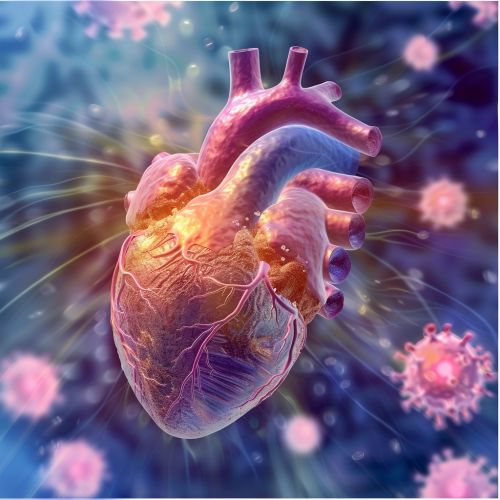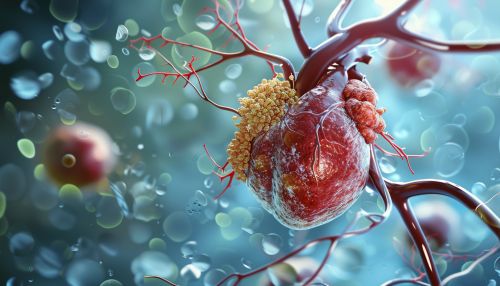Cardiac Regeneration
Introduction
Cardiac regeneration refers to the process by which damaged or diseased heart tissue is repaired or replaced by new functional cardiac cells. This field of research holds significant promise for treating various forms of heart disease, particularly myocardial infarction, which results in the loss of cardiomyocytes and subsequent heart failure. Unlike some tissues in the body, the heart has a limited capacity for self-repair, making cardiac regeneration a critical area of study.
Mechanisms of Cardiac Regeneration
Cardiac regeneration can occur through several mechanisms, including the proliferation of existing cardiomyocytes, the activation of cardiac stem cells, and the transdifferentiation of non-cardiac cells into cardiomyocytes.
Cardiomyocyte Proliferation
Cardiomyocyte proliferation involves the division of existing heart muscle cells to replace lost or damaged cells. In mammals, this process is highly restricted and primarily occurs during early development. However, recent studies have shown that certain interventions, such as the administration of growth factors or the manipulation of specific signaling pathways, can induce limited cardiomyocyte proliferation in adult hearts.
Cardiac Stem Cells
Cardiac stem cells (CSCs) are a population of progenitor cells within the heart that have the potential to differentiate into various cardiac cell types, including cardiomyocytes, endothelial cells, and smooth muscle cells. These cells are primarily located in the epicardium and the atria. Research has focused on isolating and expanding these cells in vitro and then transplanting them into damaged hearts to promote regeneration.
Transdifferentiation
Transdifferentiation refers to the process by which non-cardiac cells, such as fibroblasts, are reprogrammed to become cardiomyocytes. This can be achieved through the introduction of specific transcription factors that alter the cell's gene expression profile. This approach has shown promise in animal models, where reprogrammed cells have been integrated into the heart tissue and contributed to improved cardiac function.
Molecular Pathways Involved in Cardiac Regeneration
Several molecular pathways play crucial roles in regulating cardiac regeneration. These include the Wnt signaling pathway, the Notch signaling pathway, and the Hippo signaling pathway.
Wnt Signaling Pathway
The Wnt signaling pathway is involved in various developmental processes and has been shown to regulate cardiomyocyte proliferation and differentiation. Activation of Wnt signaling can promote the expansion of cardiac progenitor cells, while its inhibition can enhance the differentiation of these cells into mature cardiomyocytes.
Notch Signaling Pathway
The Notch signaling pathway is essential for cell fate determination and tissue homeostasis. In the context of cardiac regeneration, Notch signaling has been implicated in the regulation of cardiac stem cell activity and the promotion of angiogenesis, which is the formation of new blood vessels.
Hippo Signaling Pathway
The Hippo signaling pathway controls organ size by regulating cell proliferation and apoptosis. Inhibition of the Hippo pathway has been shown to enhance cardiomyocyte proliferation and improve cardiac function following injury.
Therapeutic Approaches
Several therapeutic approaches are being explored to enhance cardiac regeneration, including stem cell therapy, gene therapy, and tissue engineering.
Stem Cell Therapy
Stem cell therapy involves the transplantation of stem cells or progenitor cells into the damaged heart to promote regeneration. Various types of stem cells have been investigated, including embryonic stem cells, induced pluripotent stem cells (iPSCs), and cardiac stem cells. Each type of stem cell has its advantages and challenges, such as the potential for immune rejection or the risk of tumor formation.
Gene Therapy
Gene therapy aims to deliver specific genes to the heart to promote regeneration. This can be achieved through viral vectors or non-viral delivery systems. Genes that encode growth factors, anti-apoptotic proteins, or transcription factors involved in cardiomyocyte proliferation and differentiation are of particular interest.
Tissue Engineering
Tissue engineering involves the creation of bioengineered cardiac tissue that can be implanted into the heart. This approach typically combines scaffolds made of biocompatible materials with cells and growth factors to create a functional tissue construct. Advances in 3D bioprinting and biomaterials have significantly advanced this field.


Challenges and Future Directions
Despite significant progress, several challenges remain in the field of cardiac regeneration. These include the efficient delivery and integration of regenerative cells, the prevention of adverse immune responses, and the long-term stability and functionality of regenerated tissue.
Immune Response
The immune response to transplanted cells or tissues can lead to rejection and inflammation, which can impair the regenerative process. Strategies to modulate the immune response, such as the use of immunosuppressive drugs or the development of hypoimmunogenic cells, are being explored.
Cell Delivery and Integration
Efficient delivery and integration of regenerative cells into the heart tissue are critical for successful cardiac regeneration. Various delivery methods, such as direct injection, scaffold-based delivery, and encapsulation, are being investigated to improve cell retention and survival.
Long-term Stability
Ensuring the long-term stability and functionality of regenerated tissue is essential for the success of cardiac regeneration therapies. This includes maintaining the structural and functional integration of the new tissue with the existing heart tissue and preventing arrhythmias or other complications.
Conclusion
Cardiac regeneration holds great promise for the treatment of heart disease, offering the potential to repair or replace damaged heart tissue and restore cardiac function. While significant challenges remain, ongoing research and advances in stem cell biology, gene therapy, and tissue engineering continue to drive the field forward. Future developments in this area have the potential to revolutionize the treatment of heart disease and improve the quality of life for millions of patients worldwide.
